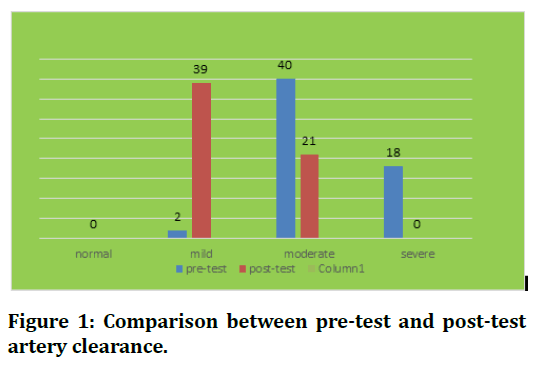Research - (2022) Volume 10, Issue 1
A Research to Determine Ozone Therapy's Efficacy on Patients with Coronary Atherosclerosis
*Correspondence: Preethi F, Sree Balaji College of Nursing, Bharath Institute of Higher Education and Research, India, Email:
Abstract
Cardiovascular disease has been on the rise in India, leading to several deaths that occur throughout the country every day. A report from the organization of the world health. In 2005, it reports that most deaths in India are primarily caused by heart disease. About eighteen crore people in India are prone to heart disease. It is estimated that 60 percent of total cardiovascular deaths worldwide will come from India. Approximately 91 patients are also projected to die every hour in India due to heart problems. In India, this problem is much higher due to lack of awareness of the disease and lack of medical facilities needed to treat patients at affordable cost.
Keywords
Assess, Effectiveness, Ozone, Therapy, Patients
Introduction
The incidence of coronary artery atherosclerosis is growing rapidly worldwide. Coronary artery disease(CAD) affects the younger Indian population than other ethnic groups with more serious and widespread angiographical involvement. It is recorded that in patients over 60 years of age, Kerala has the highest (82.8 percent) prevalence level of coronary artery disease, states in North West India such as Punjab have even higher prevalence in the younger age group. Epidemiological studies performed over the past 50 years reported a significant increase in the incidence of coronary artery disease in both urban and rural Indian populations, and CAD was expected to assume epidemic proportions in India by 2015 [1-3]. Because of its anatomical similarity to the anterior descending artery of the heart due to its anatomical proximity to the heart and outstanding long-term patency, artery bypass surgery (CABG) and internal thoracic artery.
Objectives of the study
The objectives of the study are
• To assess the degree of blood flow deficiency of the heart among pre-test group.
• To assess the efficacy of ozone therapy among the posttest group.
• To compare the result of pre-test and post-test group.
Material and Methods
The study's research layout outlines the researchers' basic strategies to establish reliable and interpretable facts. This chapter presents the researcher's methodology for the study that includes research design, variables, study setting, sample population, sample size, and sampling technique [4]. It also deals with tool development and description, pilot study, content validity and reliability, data collection process and data analysis plan. The study thus adopts an evaluative approach as the investigator's objective was to assess the effect of ozone therapy on patients with coronary atherosclerosis and myocardial infarction. Retrospective qualitative research design was the research design used in this study (Figure 1).

Figure 1. Comparison between pre-test and post-test artery clearance.
Table 1 Shows that in the pre-test Global blood flow deficiency index, the mean was 48.6 with a standard deviation of 12.3 in the post test the mean value of the overall Global blood flow deficiency index was 22.4 with a standard deviation of 6.1 clearly indicate Global blood flow deficiency index between pre-test and post-test ‘t’ value of 34.5 which is highly significant at P<0.001 level [5,6].
| Paired ‘t’ test | Post test score | Pre-test score | Variables | ||
| S. D | Mean | S. D | Mean | ||
| 34.5 P<0.001*** | 6.1 | 22.4 | 12.3 | 48.6 | Global blood flow deficiency index |
Conclusion
The present study was conducted to assess the efficacy of ozone therapy among the patients of coronary atherosclerosis between the age groups of 31-70 years. A retrospective qualitative research design was used, and the study was conducted in sree Balaji Medical College and Hospital at chrompet.
Ethical Clearance
No ethical clearance was necessary for this research work.
Source of Funding
Self-funded project.
Conflict of Interest
Nil.
References
- Théroux P. Acute Coronary Syndromes: A companion to braunwald's heart disease e-Book. Elsevier Health Sci 2010.
- Parry J. The religio athletae, Olympism and peace. Sport Spiritual 2007; 213-226.
- Connaughton M. Evidence-based coronary care. Mayo Clinic Proc 2002; 77:104. Elsevier.
- Michael Davidson. Therapeutic Lipdiology, 2nd Edn, Riedwil publications, Canada Pp: 167-168.
- https://www.austinozone.com/wp-content/uploads/Ozone-Therapy-A-Wide-Spectrum-Healer-by-Dr-Gary-Null.pdf
- Sunnen GV. Ozone in medicine: Overview and future directions. J Adv Med 1988; 1:15974.
Author Info
Sree Balaji College of Nursing, Bharath Institute of Higher Education and Research, Chennai, IndiaReceived: 06-Dec-2021, Manuscript No. JRMDS-21-46644; , Pre QC No. JRMDS-21-46644 (PQ); Editor assigned: 08-Dec-2021, Pre QC No. JRMDS-21-46644 (PQ); Reviewed: 22-Dec-2021, QC No. JRMDS-21-46644; Revised: 27-Dec-2021, Manuscript No. JRMDS-21-46644 (R); Published: 03-Jan-2022
